Is ‘X’ a good judge? Is ‘Y’ a better judge than his/her colleagues? The formal performance appraisal scheme for judges in the subordinate judiciary is supposed to facilitate an answer to such questions. However, for that to happen, there has to be a settled understanding of who is a good judge. What are the qualities and attributes which make a good judge? The prevailing practices in the various states in India offer a variety of answers. The basic framework of appraisal The performance appraisal schemes for judges in the subordinate judiciary are designed and administered by the high courts in each state. Usually, the performance appraisal consists of two important components: fulfilling a quantitative benchmark of judicial workload and an annual confidential report (ACR) filled up by the superior officers. [caption id=“attachment_1386203” align=“alignleft” width=“380”] Representational image. AFP[/caption] The ACRs generally consist of a list of indicators on which the superior officers are expected to comment. These indicators can be classified under some broad parameters of assessment such as temperament, communication skills, etc, although there is no structured classification of indicators in most of ACR proforma. One would hope that curation of such indicators is based on the attributes that are expected in a good judge. However, it seems different high courts in India have different ideas in this respect. Varying emphasis on parameters of assessment An analysis of the indicators in the ACR proforma of 11 states (Assam, Manipur, Odisha, Chhattisgarh, Madhya Pradesh, Karnataka, Tamil Nadu, Maharashtra, Gujarat, New Delhi and Uttar Pradesh) reveals a pretty uneven distribution of emphasis. Firstly, the total number of indicators in ACR proforma varies from state to state. Thus, while the ACR proforma in Chhattisgarh invites comments of the superior officer on 13 indicators, the number in Madhya Pradesh is 11. More importantly, the internal distribution of indicators in the ACR in terms of broad parameters (knowledge of the law, character traits, temperament, communication skills, workload management and others) also varies. In Assam, only 6.25 percent of indicators in the ACR pertain to the judge’s knowledge of the law. In Uttar Pradesh, the corresponding figure is 25.93 percent. In Manipur, 8.33 percent of indicators are in relation to the communication skills of a judge. In Delhi, it is 18.18 percent. In seven states (Assam, Manipur, Odisha, Chhattisgarh, Maharashtra, Delhi, Uttar Pradesh), indicators about the ‘workload management’ of the judge constitute the maximum proportion in the ACR proforma. In Gujarat, Madhya Pradesh, Karnataka and Tamil Nadu, the maximum number of indicators were related to the ‘temperament’ of a judge. [caption id=“attachment_7435991” align=“alignnone” width=“825”]
 Figure 1: Distribution of Indicators in ACR Proforma[/caption] Not fond of quantitative yardsticks? The problem is not simply that each state has its own emphasis in terms of the number of indicators for different parameters of assessment. The bigger problem lies in the lack of clarity on weightage given to various indicators. In only Maharashtra, Gujarat, Manipur and Assam, a quantitative weightage is prescribed in relation to various indicators and the ratings of ‘good’, ‘average’, etc, in the ACR are linked with the numerical score that a judge secures. For example, a judge in Maharashtra will get a rating of ‘average’ if he/she scores 41-50 and ‘good’ if he/she scores 51-60. In Maharashtra, although indicators concerning the parameter of ‘knowledge of the law’ constitute only 17.65 percent of the ACR proforma, it carries the maximum quantitative weightage. In Manipur, the parameter of ‘workload management’ has the maximum proportion of indicators (33.33 percent) and also the maximum quantitative weightage. Admittedly, certain indicators such as honesty or integrity are not amenable to a quantitative measurement. It would be absurd for a judge to be awarded scores out of 10 depending on his/her degree of honesty. Thus in Assam, Manipur and Gujarat, there is no numerical assessment of the indicators on the integrity of a judge. In relation to certain other indicators, while quantitative measurement may be desirable, it’s likely that there will be practical difficulties in implementing an evaluation framework. However, for a substantial majority of the indicators, numerical weightage makes good practical sense. It provides a degree of objectivity and transparency to the ratings given to judges in the ACR. In other states, which do not have quantitative weightage for the indicators and no numerical threshold prescribed for different ratings, there is no objective foundation as to when a judge becomes ‘good’ from ‘average’ or ‘very good’ from ‘good’. Variety for the sake of it? It is important to remember that the Constitution permits such varieties. The high courts have substantial autonomy in how they frame the performance appraisal system for the judges in the subordinate judiciary. The problem is not that the systems vary in different states. The problem is that there does not seem to be any methodological foundation for these differences. There is no clear reason why indicators on ‘temperament’ constitute only 9.09 percent of the ACR proforma in New Delhi but 36 percent in Karnataka. There is no reasoned explanation of why the ACR ratings in Maharashtra are based on clear quantitative gradations but not in Odisha. In different states, there are differences in the conditions of work, infrastructural support and many other factors. However, such differences do not alter the idea of a who is a good judge and what is expected of our judges. The basic work of a judge remains the same no matter which part of the country he/she is in. Barring local laws, the majority of the laws that judges apply also remains the same. The attributes of a good judge do not change as we cross every state border and thus, the parameters on which performance of judges is appraised should also not be so different in each state. The author is a Fulbright Post-Doctoral Research Scholar, Harvard Law School.
Figure 1: Distribution of Indicators in ACR Proforma[/caption] Not fond of quantitative yardsticks? The problem is not simply that each state has its own emphasis in terms of the number of indicators for different parameters of assessment. The bigger problem lies in the lack of clarity on weightage given to various indicators. In only Maharashtra, Gujarat, Manipur and Assam, a quantitative weightage is prescribed in relation to various indicators and the ratings of ‘good’, ‘average’, etc, in the ACR are linked with the numerical score that a judge secures. For example, a judge in Maharashtra will get a rating of ‘average’ if he/she scores 41-50 and ‘good’ if he/she scores 51-60. In Maharashtra, although indicators concerning the parameter of ‘knowledge of the law’ constitute only 17.65 percent of the ACR proforma, it carries the maximum quantitative weightage. In Manipur, the parameter of ‘workload management’ has the maximum proportion of indicators (33.33 percent) and also the maximum quantitative weightage. Admittedly, certain indicators such as honesty or integrity are not amenable to a quantitative measurement. It would be absurd for a judge to be awarded scores out of 10 depending on his/her degree of honesty. Thus in Assam, Manipur and Gujarat, there is no numerical assessment of the indicators on the integrity of a judge. In relation to certain other indicators, while quantitative measurement may be desirable, it’s likely that there will be practical difficulties in implementing an evaluation framework. However, for a substantial majority of the indicators, numerical weightage makes good practical sense. It provides a degree of objectivity and transparency to the ratings given to judges in the ACR. In other states, which do not have quantitative weightage for the indicators and no numerical threshold prescribed for different ratings, there is no objective foundation as to when a judge becomes ‘good’ from ‘average’ or ‘very good’ from ‘good’. Variety for the sake of it? It is important to remember that the Constitution permits such varieties. The high courts have substantial autonomy in how they frame the performance appraisal system for the judges in the subordinate judiciary. The problem is not that the systems vary in different states. The problem is that there does not seem to be any methodological foundation for these differences. There is no clear reason why indicators on ‘temperament’ constitute only 9.09 percent of the ACR proforma in New Delhi but 36 percent in Karnataka. There is no reasoned explanation of why the ACR ratings in Maharashtra are based on clear quantitative gradations but not in Odisha. In different states, there are differences in the conditions of work, infrastructural support and many other factors. However, such differences do not alter the idea of a who is a good judge and what is expected of our judges. The basic work of a judge remains the same no matter which part of the country he/she is in. Barring local laws, the majority of the laws that judges apply also remains the same. The attributes of a good judge do not change as we cross every state border and thus, the parameters on which performance of judges is appraised should also not be so different in each state. The author is a Fulbright Post-Doctoral Research Scholar, Harvard Law School.
An analysis of the indicators used to appraise the performance of judicial officers in high courts reveals the definition of a good judge changes as one crosses a state border
Advertisement
End of Article


)

)
)
)
)
)
)
)
)



